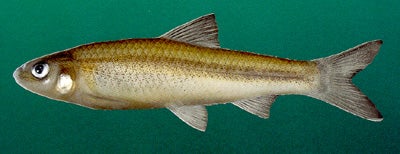MISSISSIPPI SILVERY MINNOW
SCIENTIFIC NAME: Hybognathus nuchalis
CHARACTERISTICS: The Mississippi silvery minnow resembles the cypress minnow, Hybognathus hayi, but the former has a more cylindrical body and a rounded profile. Other differences include the melanophores on the anterior part of the lateral band, which are noticeably larger than those on the sides and back of H. nuchalis, and a snout that projects slightly beyond the upper lip. In H. nuchalis the dorsal and anal fins are placed more posteriorly than those in H. hayi. Also, the midline along the back is broader than the dorsal fin base. Burr and Mayden (1982a) report that, for all sizes, the eye-to-mouth distance (measured from the upper orbital rim down to a perpendicular line extending posteriorly from the mouth corner) is always greater in H. nuchalis than in H. hayi.
ADULT SIZE: 3 to 3.9 in (75 to 100 mm)
DISTRIBUTION: This species occurs throughout the Mississippi River basin, from Minnesota south to the Brazos River and east to the Mobile basin. It inhabits the Tennessee River drainage and the Mobile basin below the Fall Line. The status of the Tennessee River populations is unknown, because few individuals have been discovered there since the river was impounded in the 1930s (Etnier et al., 1979). It may be that the species has been extirpated from this drainage in Alabama.
HABITAT AND ECOLOGY: Mississippi silvery minnows are common in low-gradient rivers and streams. The fact that they often abundant just upstream of where streams enter larger rivers or impoundments indicates a preference for flowing conditions. Fingerman and Suttkus (1961) report similar habitat requirements (which differ from those of H. hayi, which seems to inhabit only quiet, still backwaters and pools over muddy bottoms). Hybognathus nuchalis lives near silty, muddy bottoms, consuming the bottom ooze and digesting the plant and animal matter it contains. Spawning occurs from January through April in quiet waters along the margins of streams and in the backwaters and overflow pools of large rivers. The field notes of R. D. Suttkus indicate an early end to spawning in the Pearl River (January-March) and a later beginning in the Alabama River drainage (March-April). Juveniles are found from May through July. Spawning behavior is presumably similar to that of the eastern silvery minnow, H. regius (Raney, 1939), which releases nonadhesive eggs onto the bottoms of cove backwaters.
ORIGINAL DESCRIPTION: Agassiz described the Mississippi silvery minnow in 1855.
ETYMOLOGY:
Hybognathus means swollen jaw.
Nuchalis means nape.
The copyrighted information above is from Fishes of Alabama and the Mobile Basin.






